
Newsletter of the Shell Club of Sydney
NSW Branch, The Malacological Society of Australasia Limited ACN 067 894 848
An interesting find at Long Bay
By Michael Keats
The NSW Branch of the MSA held the 2002 Christmas picnic at Long Bay on the 21st December. The low tide was late in the afternoon with a suggested get together time of 3.00 p.m.
As the area is "off limits" for live collecting I focussed my efforts to extracting as much as I could from the very rich beach wash and grit on the north side of the bay, a few metres east of the boat ramp.
"My bag" of goodies was impressive with great variety. (Lots of Cypraea, Conus, Trochid, Collumbellid and Epitonid species. The quality of the material is also very acceptable. The find of the day for me was a single specimen of the Thaid,
Pinaxia versicolor (Gray, 1839). The collected specimen is 11 mm in length.
Obtaining an ID for this little beast took some research. The key document which helped was one of Bernard Cotton's publications for the Malacological Club of Victoria, dated 1st July 1956 "Publication No. 1 Family Thaididae". The illustration tends to exaggerate the diagnostic features which is a help. Cotton's description was very simple. 'Variegated purple. Yellowish, narrow brown spiral bands. Three-quarters of one inch. Q., Caloundra'
Armed with this information I then consulted Barry Wilson's Australian Marine Shells Vol 2. If ever there was a case for not relying on colour as a guide this was it! Barry's choice of material to illustrate this species must be at the opposite extreme of the colour range to my specimen. It is bright yellow! His description is more helpful and I am now 90% sure of the ID.
It reads "Thin-shelled, ovate to obconical, spire low, body whorl inflated and with sharply angulate shoulder, siphon canal short, wide, open; suture slightly channelled, with a weakly nodulose, irregular sub-sutural rib; sub sutural ramp steep, spirally striate, shoulders coronate, at least on the early whorls; aperture wide, outer lip thin, columella smooth. Yellow-orange with darker flames at the shoulders and spiral rows of short brown lines encircling the body whorl.
2.3 cm. Indo -West Pacific; Barrow I., W.A to Central NSW
Also at the Long Bay Field Trip
By Steve Dean
Different members went to different areas around the bay. At the head of the bay there is a beach and some people focused on the shell grit on this beach. The most interesting finds here included a few
Marinella haswelli. (This is the only chocolate coloured Margin in NSW most of the 48 or so species are white or cream,
while three species have pale bands).
At the northern end of the beach there is a rock platform with suitable rocks for turning. The most common species here was
Cypraea caputserpentis although many had very worn dorsums due to chemicals in a storm water drain that runs over them at this end o f the beach.
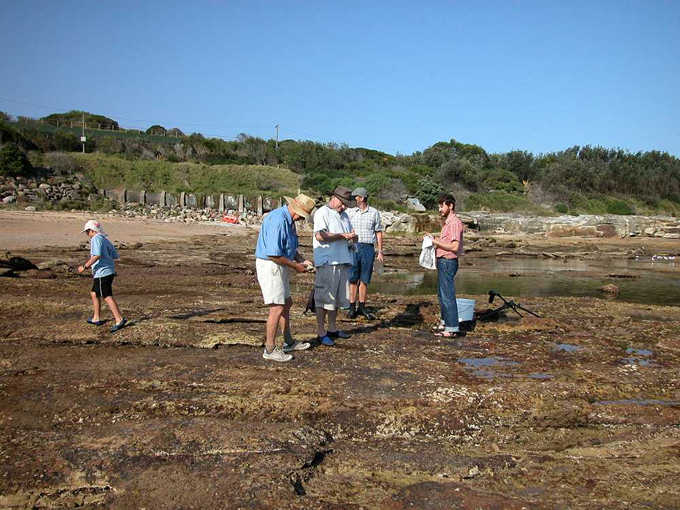
There were a number of interesting small shells observed here, including
Linopyrga pascoei
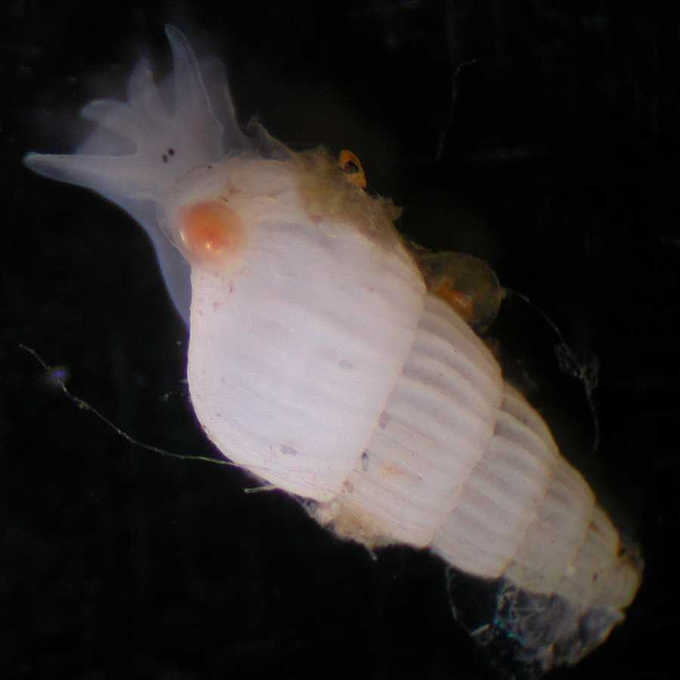
and Chryseulima_brazieri.
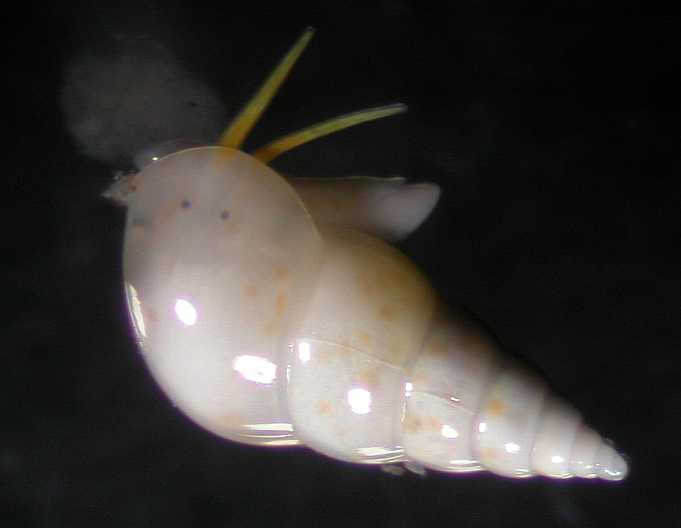
The bay is long and thin, hence its name. Half way along the northern rock platform is a boat ramp over rock, and next to it a sandy beach covered in small shells. (This is where Michael found the shells referred to in his article) The rock platform in front of this small beach has many good rocks to look under. Here there was a good number of
Elatrivia merces alive, some juvenile some mature.
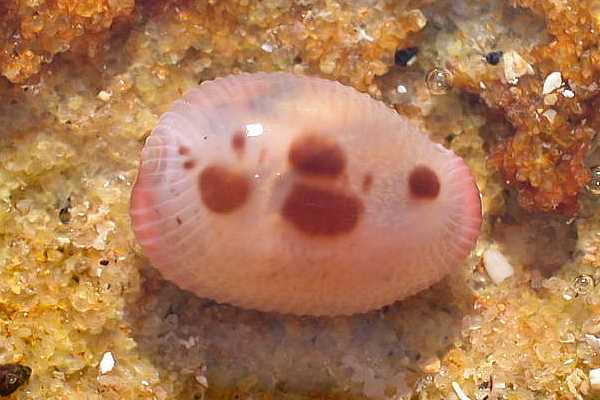
There were also many
Conus anemone in the sand under the rocks.
Ashley went for a dive in the bay to see what was there. He said it was full of sting rays. He brought back some shells to photograph at the shores edge, including
Phasianella ventricosa alive. None of us had seen these alive in Sydney before.
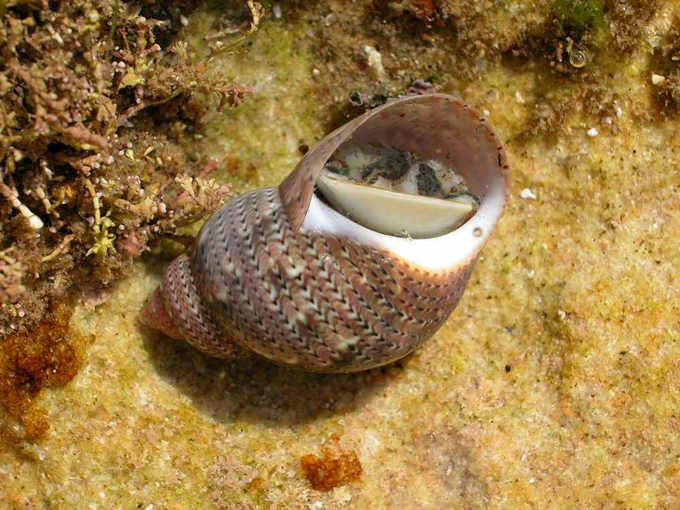
Field Day 16/02/03 Notes and Observations
By John Franklin
Little Bay is located behind Prince Henry Hospital (the old Coast Hospital) and adjoins the Coast Golf Course. Literally the bay is surrounded by Golf Courses, with St. Michaels Golf Club to the north and Randwick Golf Club to the south.
The area forms steep to gentle grassy slopes to a sandy beach. In recent times the bay has become rather shallow due to the sand being washed in from the ocean.
Observations took place under a rather dull sky with a low tide occurring at 3:15pm on the 16th February 2003.
Class Gastropoda
Turbinidae:
Astraea tentoriiforme (Jonas 1845)
Astralium kesteveni, Iredale 1924
Turbo imperialis, Gmelin 1791
Subninella undulata (Lightfoot 1786)
Ninella torquata (Gmelin 1791)
Nacellidae:
Cellana tramoserica (Holten 1802)
Lottiidae:
Patelloida alticostata (Angas 1865)
Haliotidae:
Haliotis rubra rubra, Leach 1814
Fissurellidae:
Scutus antipodes, Montfort 1810
Trochidae:
Clanculus brunneus, A. Adams 1853
Clanculus clanculus (Wood 1828)
Austrocochlea concamerata (Wood 1828)
Austrocochlea porcata (A. Adams 1853)
Cantharidella picturata (A. Adams & Angas 1864)
Gena impertusa (Burrows 1815)
Neritidae:
Nerita atramentosa, Reeve 1855
Planaxidae:
Hinea brasilana (Lamarck 1822)
Littorinidae:
Nodilittorina unifasciata, Gray 1826
Nodilittorina acutispira, Smith 1892
Cypraeidae:
Cypraea caputserpentis, Linneus 1758
Cassidae:
Semicassis labiata (Perry 1811)
Ranellidae:
Charonia lampas rubicunda (Perry 1811)
Muricidae:
Bedeva hanleyi (Angas, 1867)
Agnewia tritoniformis (Blainville 1832)
Morula marginalba, Blainville 1832
Dicathais orbita, Gmelin 1791
Columbellidae:
Mitrella tayloriana (Reeve 1859)
Siphonariidae:
Siphonaria diemenensis (Quoy & Gaimard 1833)
Class Bivalvia
Veneridae:
Irus crenatus (Lamarck 1818)
2003 Hilltop to Headland Environmental Lecture Series
Further details from John Franklin
Hilltop to Headland is an environmental lecture series that has been operating in Warringah since 1996. Presented by Warringah Council, the series involves environmental experts presenting free community based talks and workshops on a range of environmental topics.
The 2003 Hilltop to Headland lecture series promises to be a great success with a range of exciting topics including local wildlife, native plants, marine life and even economics.
A special thank you to all presenters who have given their time to be a part of this exciting program and to Councillor Phil Colman of Warringah Council who has been coordinating the program for the past seven years.
All lectures are held on the third Wednesday of the month from February to November in Warringah Council Chambers.
Venue: Warringah Council Chambers
Civic Drive, Dee Why
Time: 7pm to 8:30pm
Cost: Free. Donations are welcome
Enquiries: Environment Education Team
(02) 9942 2542
Entry is free.
19th March 2003
Can Ecology and Economics be Integrated?
Jack Mundey - Veteran Environmentalist
16th April 2003
Attracting Birds to your Backyard
Tony Saunders - Avi Faunal Consultants
21st May 2003
Platypus Conservation
Dr Tom Grant - Honorary visiting Fellow, School of Biological, Earth and Environmental Science, University NSW
18th June 2003
What's Happening to our Bushland?
Conservation and Land Management Team - Warringah Council
16th July 2003
Water Conservation in the Home
Steve Baxter - Manager, Marketing and Customer Relations, Sydney Water
20th August 2003
Sustainable use of the Australian Continent
Dr Mary White - Local Author
17th September 2003
Marine Ecology, Bio-physical Interactions in the Sea
Dr Arthur Dye - Deputy Director, Centre for Research on Ecological Impacts of Coastal Cities, University of Sydney
15th October 2003
What's Happening with our Creeks and Waterways?
Catchment Management Team - Warringah Council
19th November 2003
Flesh to Flashes. Fabulous Opal Fossils from Lightning Ridge.
Mr Henk Godthelp - School of Biological, Earth and Environmental Science, University NSW
Questionnaire:-
John Franklin
Set out below are questions, the answers to which should be published in the next issue of the Sheller. The purpose of the exercise is to stimulate interest and research. Having regard to the requirements of the Dept. of Fisheries and other institutions for the issue of a permit, perhaps one day your research could lead to the issue of a Certificate of Merit, even a degree. Should any member have questions (with answers) that they feel could make a contribution, please advise.
A. Early Literature
Q1 The first illustrated book on shells was published in Rome in 1681.
(a) Who was the author?
(b) What was the title of the work?
Q2 In 1685 Martin Lister published an illustrated book to help readers identify shells.
(a) What was the title of this publication?
Q3 In 1742 a Frenchman published a very popular book on shells.
(a) Who was he?
Q4 Carl von Linnaeus conceived a system of nomenclature.
(a) What was the system?
(b) When did he publish his book?
(c) Why was it important?
Q5 Who was the author of "Delight of Eyes and Mind", in six volumes (1760-73)?
B. Molluscs
(a) Phylum mollusca is the largest in the animal kingdom. True or false?
(b) Phylum mollusca is divided into several classes. Name six in the order of most primitive first.
(c) The visceral mass of a mollusc's body contains the circulatory, digestive, reproductive and excretory organs. Name four other essential parts.
(d) Located at the back of the mouth of a mollusc's body is the pharynx containing the radula.
(i) What is the structure of the radula?
(ii) Why is the structure so important?
(e) The heart pumps haemolymph (blood); what two respiratory substances does it convey through the body?
(f) If a shell coils from left to right, it can be said to be ………………. ?
(g) If a shell coils from right to left, it can be said to be ………………. ?
(h) The operculum can be thin or thick, what two substances/properties can it consist of?
(i) Whilst shells are formed by the mantle secreting conchiolin consisting of calcium carbonate, the cells in the mantle secrete other substances. What are these substances and why are they so important?
(j) (i) Name three kinds of layers of a shell.
(ii) Cowries and very smooth shells do not possess one of these layers. Which layer is missing in these
shells?
Shell Club Minutes 23/11/2002.
The meeting was opened by P Jansen at 2.00 pm.
Field Trips
M. Keats reported on a trip to Boat Harbour.
P. Jansen reported on a trip to Shell Harbour and Bass Point.
The meeting decided that the Christmas Field trip would be to Long Bay, Malabar on the 21st of December and the social function would be held at the Hawks Nest Restaurant of RELC on the 7th of December.
John Franklin to inform members not present at the meeting.
Presentation
Ashley Miskelly on Christmas Island in the Indian Ocean.
Ashley talked about the indigenous red crabs and their life cycle, the robber crabs (or coconut crabs) and showed some fabulous slides. Ashley discussed one of his pet interests: the black plate urchins, which inhabit the island.
The meeting showed its enjoyment and appreciation of Ashley's presentation with a round of applause.
General Business
Michael Keats will send off a letter of thanks to Sir Rupert Myers for allowing the club to auction the late Lady Io Myers' collection with proceeds going to the club.
Letter from Tom Caddey of Tathra wanting membership details.
Meeting closed at 2.47pm
C. & K. Barnes
Secretary
Shell Club Minutes 25/01/2003.
The meeting was opened by P Jansen at 2.10 pm.
Field Trips
A field trip is planned for Little Bay on Sunday 16th February at 12 noon.
Presentation
5 minute members talks:
S. Clarke discussed part of her PhD research project on the Population of Western Sydney Snails on the Cumberland Plains
J. Dunkerley talked about a form "glivella" (fewer black streaks, more inflated) of
Cypraea isabella Linnaeus, 1758.
M. Keats initially talked about land snails from the Strickland forest extension walk and secondly, about finds from Long Bay
Iincluding Pinaxia versicolor Gray, 1839 and Recluzia hargravesi Cox, 1870.
C. Barnes displayed and discussed shells from Long and Little Bays, including, Cypraea poraria Linnaeus, 1758,
Cypraea fimbriata Gmelin, 1791 and a 43.3mm specimen C. caputserpentis
Linnaeus 1758, also a specimen of Hydatina royana
R. Moylan talked about a recent visit to East Diamond Island and Lihou reef where he collected
Cymbiola perplicata (Hedley, 1902), up to 96mm in the deeper water outside the lagoon, though the current world record still stands at 103.4mm.
P. Jansen talked about the family visit to Victoria, including Port Campbell, near the Twelve Apostles. A rock platform at low tide was found to have
Conus anemone Lamarck, 1810, and various Nudibranchs in pools.
S Dean talked about a Museum dredging trip In the Ocean near Sydney and in Broken Bay.
Meeting closed at 3.32pm
C. & K. Barnes
Secretary
|





